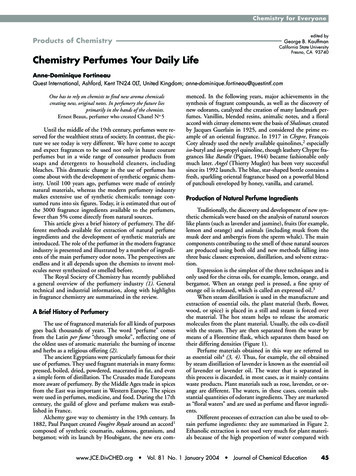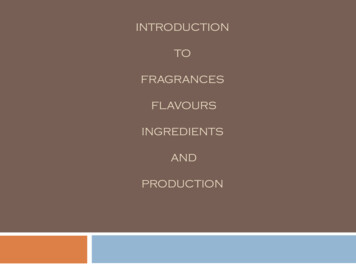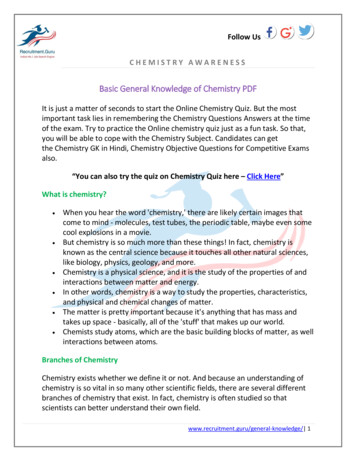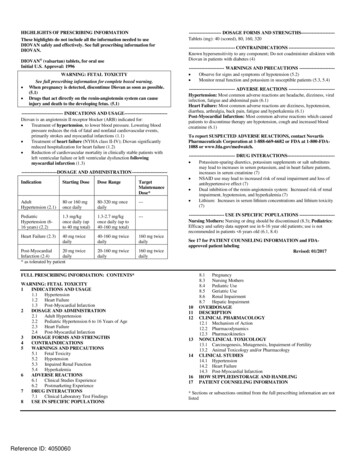
Transcription
Chemistry for Everyoneedited byProducts of ChemistryGeorge B. KauffmanCalifornia State UniversityFresno, CA 93740Chemistry Perfumes Your Daily LifeAnne-Dominique FortineauQuest International, Ashford, Kent TN24 0LT, United Kingdom; anne-dominique.fortineau@questintl.comOne has to rely on chemists to find new aroma chemicalscreating new, original notes. In perfumery the future liesprimarily in the hands of the chemists.Ernest Beaux, perfumer who created Chanel No 5Until the middle of the 19th century, perfumes were reserved for the wealthiest strata of society. In contrast, the picture we see today is very different. We have come to acceptand expect fragrances to be used not only in haute coutureperfumes but in a wide range of consumer products fromsoaps and detergents to household cleaners, includingbleaches. This dramatic change in the use of perfumes hascome about with the development of synthetic organic chemistry. Until 100 years ago, perfumes were made of entirelynatural materials, whereas the modern perfumery industrymakes extensive use of synthetic chemicals: tonnage consumed runs into six figures. Today, it is estimated that out ofthe 3000 fragrance ingredients available to the perfumers,fewer than 5% come directly from natural sources.This article gives a brief history of perfumery. The different methods available for extraction of natural perfumeingredients and the development of synthetic materials areintroduced. The role of the perfumer in the modern fragranceindustry is presented and illustrated by a number of ingredients of the main perfumery odor notes. The perspectives areendless and it all depends upon the chemists to invent molecules never synthesized or smelled before.The Royal Society of Chemistry has recently publisheda general overview of the perfumery industry (1). Generaltechnical and industrial information, along with highlightsin fragrance chemistry are summarized in the review.A Brief History of PerfumeryThe use of fragranced materials for all kinds of purposesgoes back thousands of years. The word “perfume” comesfrom the Latin per fume “through smoke”, reflecting one ofthe oldest uses of aromatic materials: the burning of incenseand herbs as a religious offering (2).The ancient Egyptians were particularly famous for theiruse of perfumes. They used fragrant materials in many forms:pressed, boiled, dried, powdered, macerated in fat, and evena simple form of distillation. The Crusades made Europeansmore aware of perfumery. By the Middle Ages trade in spicesfrom the East was important in Western Europe. The spiceswere used in perfumes, medicine, and food. During the 17thcentury, the guild of glove and perfume makers was established in France.Alchemy gave way to chemistry in the 19th century. In1882, Paul Parquet created Fougère Royale around an accord1composed of synthetic coumarin, oakmoss, geranium, andbergamot; with its launch by Houbigant, the new era comwww.JCE.DivCHED.org menced. In the following years, major achievements in thesynthesis of fragrant compounds, as well as the discovery ofnew odorants, catalyzed the creation of many landmark perfumes. Vanillin, blended resins, animalic notes, and a floralaccord with citrusy elements were the basis of Shalimar, createdby Jacques Guerlain in 1925, and considered the prime example of an oriental fragrance. In 1917 in Chypre, FrançoisCoty already used the newly available quinolines,2 especiallyiso-butyl and iso-propyl quinoline, though leathery Chypre fragrances like Bandit (Piguet, 1944) became fashionable onlymuch later. Angel (Thierry Mugler) has been very successfulsince its 1992 launch. The blue, star-shaped bottle contains afresh, sparkling oriental fragrance based on a powerful blendof patchouli enveloped by honey, vanilla, and caramel.Production of Natural Perfume IngredientsTraditionally, the discovery and development of new synthetic chemicals were based on the analysis of natural sourceslike plants (such as lavender and jasmine), fruits (for example,lemon and orange) and animals (including musk from themusk deer and ambergris from the sperm whale). The maincomponents contributing to the smell of these natural sourcesare produced using both old and new methods falling intothree basic classes: expression, distillation, and solvent extraction.Expression is the simplest of the three techniques and isonly used for the citrus oils, for example, lemon, orange, andbergamot. When an orange peel is pressed, a fine spray oforange oil is released, which is called an expressed oil.3When steam distillation is used in the manufacture andextraction of essential oils, the plant material (herb, flower,wood, or spice) is placed in a still and steam is forced overthe material. The hot steam helps to release the aromaticmolecules from the plant material. Usually, the oils co-distilwith the steam. They are then separated from the water bymeans of a Florentine flask, which separates them based ontheir differing densities (Figure 1).Perfume materials obtained in this way are referred toas essential oils4 (3, 4). Thus, for example, the oil obtainedby steam distillation of lavender is known as the essential oilof lavender or lavender oil. The water that is separated inthis process is discarded, in most cases, as it mainly containswaste products. Plant materials such as rose, lavender, or orange are different. The waters, in these cases, contain substantial quantities of odorant ingredients. They are marketedas “floral waters” and are used as perfume and flavor ingredients.Different processes of extraction can also be used to obtain perfume ingredients: they are summarized in Figure 2.Ethanolic extraction is not used very much for plant materials because of the high proportion of water compared withVol. 81 No. 1 January 2004 Journal of Chemical Education45
Chemistry for oluteFigure 1. Florentine flasks, used to separate aqueous and oil phases.Figure 2. Extraction techniques: processes are written over the arrows and technical names for the products are circled.oil in the plant (vanilla beans are an important exception).The extraction process is more important with materials suchas civet or ambergris, which are secreted by animals. Thesperm whale produces a triterpene known as ambreine in itsintestinal tract. This compound is excreted into the sea and,on exposure to salt water, air, and sunlight, undergoes a complex series of degradative reactions that produce the materialknown as ambergris. This extremely valuable and rare waxysubstance can be found floating in the sea or washed up onbeaches. Extraction of it with ethanol produces the uniquetincture of ambergris.Enfleurage was used by ancient Egyptians to extract perfume ingredients from plant material and exudates. Its usecontinued up to the 20th century, but it is now of no commercial significance. In enfleurage, the natural material (petalsof flowers for example) is laid on purified fat every day for amonth. The perfume oils diffuse into the fat over time andthen the fat is melted and the whole mixture filtered to remove solid matter. The odorous oils are extracted from thefat with alcohol. Once the ethanol is distilled off, the product is known as an absolute.5 This technique presents a fewdisadvantages: the concentration of the odorous oil is low,fat is not the most pleasant material to handle, and it turnsrancid after a number of uses.The most important extraction technique nowadays issimple solvent extraction. Petroleum ether, acetone, hexane,and ethyl acetate, together with various combinations ofthese, are typical solvents used. Recently, there has been agreat deal of interest in the use of carbon dioxide as an extraction solvent. The pressure required to liquefy carbon dioxide at ambient temperature is considerable and thus thenecessary equipment is expensive. This is reflected in the costof the oils produced, but carbon dioxide has the advantagethat it is easily removed and produces very high quality oilswithout any concerns about residual solvent levels. The product of an extraction is called a concrete6 or resinoid. It canbe extracted with ethanol to yield an absolute, or distilled togive an essential oil. The oil can be deterpenated. The use ofthe word terpene may be misleading to the chemist since, inthis instance, it refers specifically to monoterpenoid hydrocarbons. Hence, a terpeneless oil is one from which the hydrocarbons have been removed to leave only the oxygenatedspecies and so increase the strength of its odor.Essential oils and other extracts vary considerably in priceand volume. Lavender, for example, is a relatively inexpensive oil, costing 22– 30 per kg, and 250–300 tons are usedannually. Rose and jasmine are more expensive and are usedin much smaller quantities. The total annual production ofrose oil is 15–20 tons and it costs between 1500 and 4500per kg, depending on quality. About 12 tons of jasmine extracts are produced annually at prices of up to 3000 per kg.Eucalyptus oil is one of the cheapest oils at 3– 4.5 per kg.The exact balance between volume and price depends on various factors such as ease of cultivation, ease of extraction, andusefulness. For example, eucalyptus trees grow well, the leavesare easy to harvest, trimmed trees grow back vigorously, theoil is easily distilled, and it is useful as a disinfectant as wellas a camphoraceous fragrance ingredient. All of these factorscombine to make it a high tonnage oil.As mentioned previously, before the 20th century, perfumes were reserved for the wealthiest people. This is becauseperfumers relied on natural sources for their ingredients. Mostof these ingredients were in limited supply and were expensive to produce. For example, it takes about seven millionjasmine flowers to produce only one kg of oil and the flowers have to be picked by hand in the first few hours of theday when their oil content is at its highest. In view of thecosts of cultivation and extraction, it is not surprising to findthat jasmine oils cost in the region of 3000 per kg.Some natural oils are much less expensive because ofautomated farming methods. For example, rows of lavenderin a field can be cut almost to ground level and fed directlyinto a still pot carried on a tractor (Figure 3). The pot is thenfitted under a field still and the oil extracted while the harvesting continues. The cost of lavender oil is thus tens, ratherthan thousands, of dollars per kilogram. Despite this, themodern perfumery industry would not be able to functionas it does if it were to rely solely on natural ingredients.46Journal of Chemical Education From Natural to Synthetic Perfume IngredientsThe use of synthetic chemicals started to grow in the19th century with the development of organic chemistry.When in 1921 “Mademoiselle” Chanel decided to launch herown perfume she asked Ernest Beaux to create a new andinnovative fragrance for her. The perfumer used for the firstVol. 81 No. 1 January 2004 www.JCE.DivCHED.org
Chemistry for Everyonetime aliphatic aldehydes to exhale the head notes of a composition rich in jasmine notes. Eighty years later Chanel N 5is still among the best selling fragrances. The success inspiredother perfumery houses to experiment with synthetic materials and the modern age of perfumery was born.Synthetic materials are cheaper to produce than naturalmaterials. For example, a very nice Bulgarian rose is one hundred times more expensive to produce from the natural sourcethan it is from synthetic materials. Nowadays, the fragrancerepresents only 3% of the price of a perfumed product forpersonal and household care, thus making perfume accessibleto all. The organic chemists are now capable of making morerobust molecules that will survive acidic, basic, and even oxidizing media. Thus, a wider range of consumer goods products can now be perfumed, where natural oils could not havebeen used because of degradation of their components, resulting in changes in odor and color. Many of the components of natural oils do not survive in products such asbleaches, laundry powders, and even soaps.The discovery and application of synthetic fragrancematerials towards the end of the 19th century and throughout the 20th century was therefore a momentous event inthe history of the industry (5). As techniques for isolation,characterization, and synthesis of organic chemicals improved,the search for new fragrance materials became more structured. In this, the fragrance industry follows the same pathas the pharmaceutical industry and relies on the analysis ofnatural sources like plants, fruits, and animals. The first stepis to identify the materials that are available from nature. Particularly in the case of flowers, fragrant volatiles are trappeddirectly by so-called “headspace” procedures. Using the nondestructive headspace trapping technique and light, portablesampling equipment (Figure 4), the fragrance of any flower,fruit, or other natural source can be collected from the field(or greenhouse) and returned to the laboratory for analysiswithout disturbing the plant.Having identified the molecular structure of an odorant, the next task is to prepare an authentic sample. Synthesis serves as the final proof of the correct determination ofthe structure, but it also makes it possible to produce thematerial without relying on the natural sources. Syntheticcompounds whose structures are the same as those of thenatural material are referred as “nature identical”. The nextstep is to prepare a range of analogues that are close in structure but not identical to the natural parent. There are twomain reasons for this: firstly, materials that demonstrate improved performance over the natural ones may be discovered;and secondly, information about the structural requirementsfor the desired odor can often be found. This leads to thedevelopment of quantitative structure–activity relationshipstechniques (6 ). This sequence can be illustrated by lookingin detail at one odor area, for example, that of jasmine. Ifone looks at a GC trace of jasmine absolute, it is clear thatthe product is a complex mixture. However, the major components of the mixture (benzyl acetate, benzyl benzoate, phytol, etc.) are not the most important contributors to thecharacteristic odor of jasmine (Figure 5).Of the 200 or so materials present in jasmine, the mostimportant for the odor are jasmone and methyl jasmonate.The cis double bond in the side chain introduces extra stagesand processing costs in the synthesis and therefore cheaperwww.JCE.DivCHED.org Figure 3. Lavender is cultivated in rows in large fields.Figure 4. Headspace equipment. The volatile molecules releasedby the flower are swept into the trap in the stream of air. The airpasses through the trap but the volatile molecules are retained.After several hours of sampling the trap is removed and taken backto the lab for analysis.OOOObenzyl benzoatebenzyl acetateOHphytolFigure 5. Major components of jasmine.Vol. 81 No. 1 January 2004 Journal of Chemical Education47
Chemistry for Everyonealternatives to jasmone are dihydrojasmone, jasmatone(Quest) and methyl dihydrojasmonate (Figure 6).Creating a Perfume, the Prerogative of “Noses”Perfumers have their own unique way of creating a fragrance. This always involves defining an atmosphere, whichwill then be translated into feelings either by reference tonatural materials or by using synthetic compounds to createa harmonious composition. In all cases, perfumers speak interms similar to those a composer would use when writing apiece of music. They speak of chords and discords; the shelfof materials they use as ingredients is referred to as an organ(Figure 7) and the individual ingredients are said to contribute notes to the overall composition.These notes are classified into head notes,7 heart notes,8and base notes.9 The head notes, often the more volatile materials in the composition, give the initial impact; the heartnotes form the bulk of the perfume; and the base notes arethe least volatile components, which fix the more volatile elements. When creating a perfume, it is important to get thecorrect balance of head, heart, and base notes. The components must work together to form a balanced overall composition. The base notes should hold the head notes back sothat the volatile elements are not lost immediately, but persist as long as the total perfume lasts. The head notes of natural perfumes are derived from, for example, citrus oils, herbssuch as rosemary and lavender, and green notes, which arethose associated with crushed foliage. Synthetic materials thatcan be used to give head notes could be aliphatic aldehydesand monoterpene esters. Aldehydes are very useful head notesmaterials in fine fragrances, but their use in more functionalproducts is restricted by their instability in the presence ofoxidizing agents and at extremes of pH.The heart notes of perfumes were originally derived fromflower oils such as rose, lily, and violet. Today, with all theaffordable violet-smelling toilet soaps available, one easily forgets that violet flower oil was the most expensive of all essential oils—at the times when it was still economic to beproduced. For the production of one kilogram of this oil33,000 kg of violet blossoms were needed. It is worth mentioning that violet leaf is still used, but the odor is green,quite unlike the flower character. The ionones were first discovered in 1893 and their violet odor revolutionized perfumery; today almost every perfume includes them, since theyblend well with basically all other perfumery materials. Thedamascones are a group of materials related to the ionones,but in which the enone unit is transposed (Figure 8). Theyare components of rose oils and have very intense fruity–floral odors. Rose notes are now available through inexpensivesynthetics such as geraniol, citronellol, and 2-phenylethanol(Figure 9).The classical base notes of perfumes fall into the wood,musk, amber, and balsam areas. Woody and amber materialsnature identical compoundsOOH3CO2Cjasmonemethyl jasmonatecyclopentanone derivativesFigure 7. Perfumer’s O2Cmethyl dihydrojasmonateα-iononeFigure 6. Components with jasmine odor.48Journal of Chemical Educationβ-iononeFigure 8. Floral oils components. Vol. 81 No. 1 January 2004 www.JCE.DivCHED.org
Chemistry for Everyonegenerally have complex sesquiterpene-like structures in whichprecise stereochemistry is frequently important in determining odor type and quality. This segment of the perfumer’sorgan is thus dominated, at present, by semisynthetic materials obtained by the modification of readily available natural precursors. Some purely synthetic materials are becomingestablished as woody and amber chemicals and these maysupersede the current generation of semisynthetic materials.Musks were originally obtained from various animal (Figure10) and plant sources such as musk deer (Moschus moschiferus,which inhabits the Himalayas from Afghanistan to China),civet cat and ambrette seed oil (distilled from seeds of Hibiscus abelmoschus).Muscone and civetone are the most important odor components of musk and civet respectively (Figure 11).Ambrettolide is a plant product, occurring in the seeds of theambrette plant, which is cultivated in Madagascar, theSeychelles, Colombia, and Ecuador. In tonnage terms,cyclopentadecanolide is one of the largest of macrocyclicmusks.In 1888, Albert Baur was searching for new types of explosives when he noticed that the product of the Friedel–Crafts reaction of trinitrotoluene (TNT) with tert-butylhalides emanated a pleasant musky smell. 2-tert-Butyl-4-methyl-1,3,5-trinitrobenzene was an immediate commercial success and became known as “musk Baur”. In 1894, Baurdiscovered and developed musk ketone, which was amongthe most used perfumery ingredients until the mid-1960s.Phantolide (PFW) was first invented in 1951 and introduced to the market a year later, even without knowledge ofthe correct structure, which was reflected in its name.Phantolide (PFW) performs better in detergents and washing powders than musk ketone, so it became the new olideFigure 11. Examples of macrocyclic musks.ONO2O2NNO2O2 Nmusk BaurOHOHOONO2musk ellolFigure 9. Compounds with rose odor.celestolideOOtraseolideFigure 10. Musk deer and civet cat used to be a source of musks.www.JCE.DivCHED.org tonalidversalideFigure 12. The musk family.Vol. 81 No. 1 January 2004 Journal of Chemical Education49
Chemistry for EveryoneRNR'OH2OHR'O NOHRaldehydeor ketoneoxazolidineON2-hydroxyl amineretroMichaelO RMichaelRHβ-amino compoundNH2enoneamineFigure 13. Examples of new fragrance-delivery systems.structure for musk odorants, and in the following years numerous derivatives were synthesized in the laboratories of theflavor and fragrance industry. Some prominent introductionsinclude Celestolide (IFF), Tonalid (PFW), Traseolide (Quest)and Versalide (Givaudan) (Figure 12).Future DirectionsMany substantive (long-lasting) odorants are known, buta great number of them are too volatile to be perceived morethan a few hours after their application. This is the reasonwhy more efficient and effective fragrance-delivery systems,especially for laundry-care products, are intensely sought.The use of “prodrugs”, an inactive drug derivative thatis converted in the body into its active form, is a well-established technology to improve the oral bioavailability or thepenetration across biological membranes. This concept,widely used by the pharmaceutical industry, was introducedto functional perfumery by Firmenich in the mid-1990s (7).Firmenich and co-workers made use of lipases that are employed in most detergents to degrade fatty stains to hydrolyse esters of fragrant alcohols. This led to the developmentof a wide range of precursors that are cleaved by hydrolysisduring the laundry process to generate in situ fragrance materials, for example, aldehydes and ketones derived fromoxazolidines and ionones and damascones from β-aminocompounds (Figure 13) have been developed by Procter &Gamble (8). Fragrance chemists are still looking for new systems with improved stability and release properties.Though fragrances are incorporated into functionalproducts to impart a pleasant odor, some odorants also possess antimicrobial properties or other secondary benefits, forinstance, insect repellent activity. Fragrance ingredients suchas eugenol, carvacrol, and thymol are known to also have bactericidal activity. However, their use is limited because at acertain concentration their odor becomes unpleasant. In order to overcome this problem, fragrance chemists have beenlooking for compounds that not only exhibit pleasant odorcharacteristics, even in higher concentrations, but also possess good antibacterial activity.The search for molecules with new and innovative odorcharacteristics is, however, still the main focus of the indus50Journal of Chemical Education try and in almost every odor note there are still plenty ofnew odorants to be discovered; stronger in odor, more transparent or more easy to overdose, exhibiting better performance in special functional products, or possessing uniquecombinations of different odor tonalities. There are endlesspossibilities and variations. Organic chemists will always beneeded to create new and ever-improving fragrance ingredients; remember what Ernest Beaux said, “In perfumery thefuture lies primarily in the hands of the chemists”.AcknowledgmentsI would like to thank Charles Sell, Karen Bridge, andSjack Elings for their helpful comments and critical review.Notes1. An accord is a blend of perfume ingredients balanced inodor intensity and having a pleasing effect. It is generally used as aperfume building block.2. Quinolines are formed by the fusion of a benzene ring witha pyridine ring, with the nitrogen atom next to the benzene ring.3. An expressed oil is a cold pressed oil in which the oil contained in the outer skin of a citrus fruit is released by rasping orcompression of the citrus fruit.4. Essential oils are steam-distilled oil obtained from plant material.5. An absolute is the alcoholic extraction of the concrete.6. The hydrocarbon extraction of the plant material is termedconcrete or resinoid.7. Head notes are the most volatile components of a perfume.They generally last a matter of minutes on the skin and are alsoreferred to as top notes.8. Heart notes are the heart of a perfume, the main theme.They last for a few hours on the skin and are also referred to asmiddle notes.9. Base notes are the substantive part of a perfume comprising the less volatile components of the fragrance composition. Theyare also referred to as end notes.Literature Cited1. Pybus, D. H.; Sell, C. S. The Chemistry of Fragrances; RSCPaperbacks: Cambridge, United Kingdom, 1999.2. The Metropolitan Museum of Art Scents of Time—Perfume fromAncient Egypt to the 21st Century, 1st ed.; Morris, E. T., Ed.;Bulfinch Press: Boston, MA, 1999.3. Gunther, E. The Essential Oils; D. van Nostrand: New York,1948; 6 vol.4. ESO–The Complete Database of Essential Oils. Product ofBoelens Aroma Chemical Information Service. http://www.leffingwell.com/baciseso.htm (accessed Oct 2003).5. Kraft, P.; Bajgrowicz, J. A.; Denis, C.; Fráter G. Angew. Chem.,Int. Ed. 2000, 39, 2980–3010.6. Rossiter, K. Perf. & Flav. 1996, 21, 33–46.7. Paget, W.; Reichlin, D.; Snowden, R. L.; Walborsky, E. C.;Vial, C. (Firmenich). Procédé de Parfumage de Textiles. WO95/04809, 1995.8. Miracle, G. S.; Gray, L. M. (Procter & Gamble Company).Aldehyde and Ketone-Releasing Pro-Fragrances. WO 00/72816, 2000.Vol. 81 No. 1 January 2004 www.JCE.DivCHED.org
Perfume materials obtained in this way are referred to as essential oils4 (3, 4). Thus, for example, the oil obtained by steam distillation of lavender is known as the essential oil of lavender or lavender oil. The water that is separated in this process is discar









